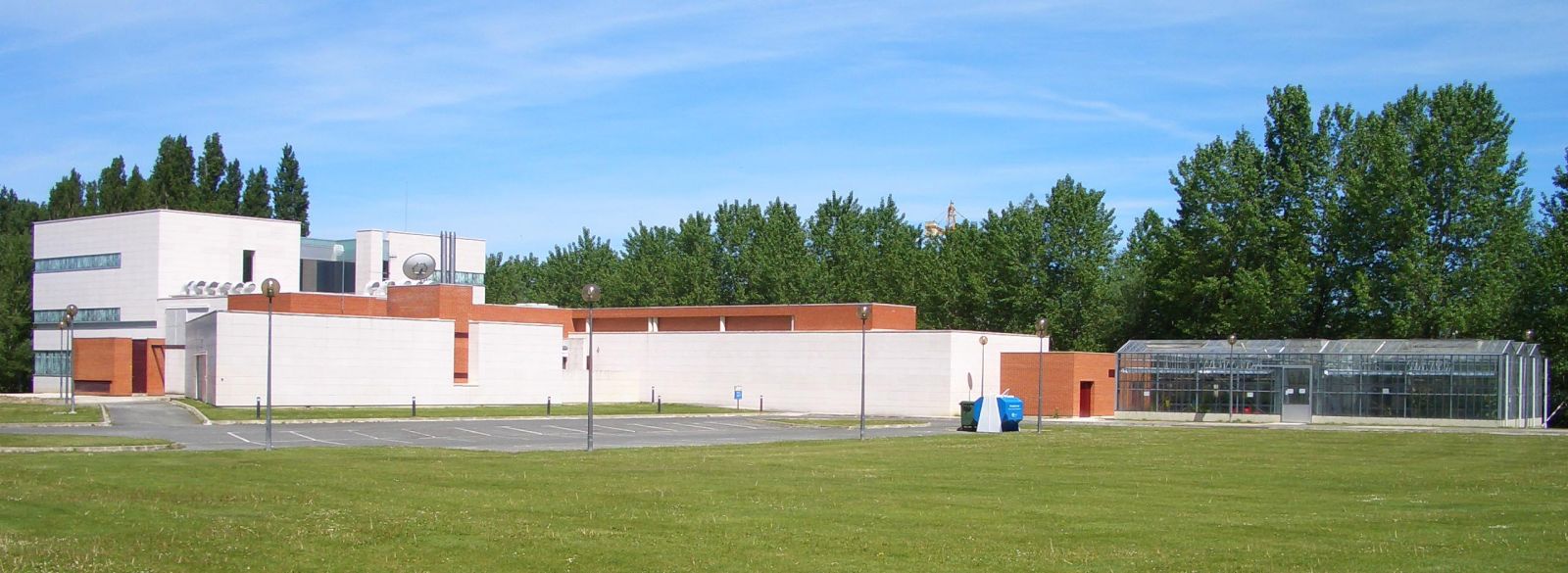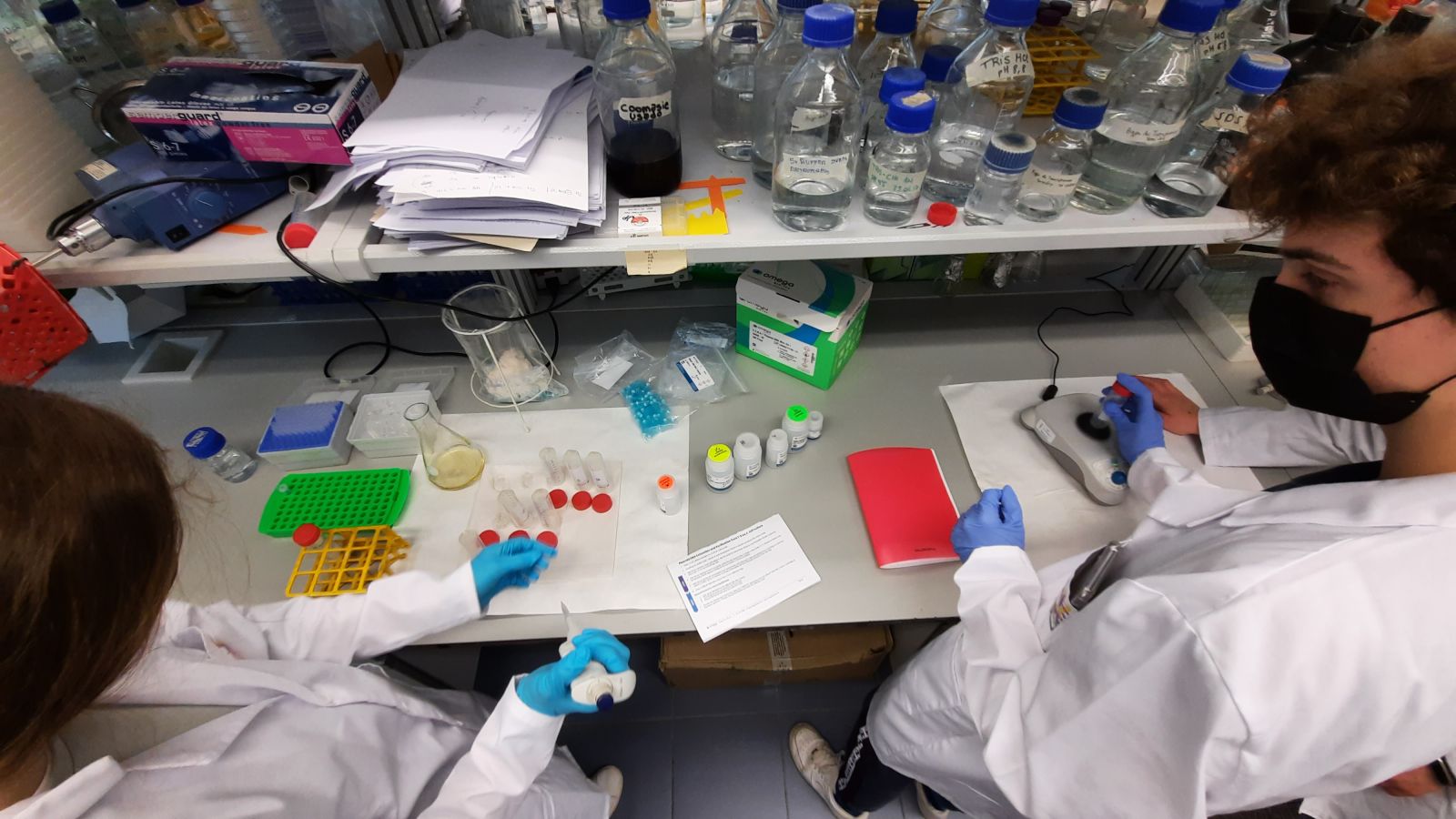
Abril fue uno de los meses más interesantes y más esperados de todo el curso, puesto que comenzó nuestra labor dentro del laboratorio dando paso a la segunda ‘fase’ del proyecto, ‘fase’ donde tuvimos que demostrar nuestra implicación con el proyecto puesto que comenzamos a dedicarle más tiempo.
Nos gustaría agradecer al equipo de IdAB-CSIC por dejarnos trabajar en sus instalaciones en el Instituto de Agrobiotecnología (IDAB-CSIC) en Mutilva y prestarnos el material de laboratorio necesario para llevar a cabo nuestra investigación. El laboratorio donde desarrollamos nuestro proyecto, tiene un nivel de bioseguridad 1 (low risk) y los organismos con los cuales hemos trabajado no presentan ningún riesgo. Cuando comenzamos este blog indicamos que nuestra primera base era el planetario, y la segunda base indispensable para este trabajo de Navarra-Biogalaxy3. Hemos tenido la suerte de ser mentorizados por grandes expertos como Edurne Baroja o Francisco Muñoz, ambos pertenecen al Grupo de Investigación de Metabolismo de Carbohidratos IdaB-CSIC.

Laboratorio de IdAB-CSIC en Mutilva.
Antes de contaros como fue la experiencia en el laboratorio, nos gustaría recordaros que el objetivo de nuestro proyecto es proporcionar protección frente a la radiación ultravioleta a plantas en Marte. Para ello hemos decidido seguir tres líneas de investigación las cuales hemos ido realizando a lo largo de nuestra estancia allí. La primera es la caracterización (prueba de las características) de las plantas genéticamente modificadas por el equipo anterior, el cual introdujo el gen Arabidopsis PAP1 en ellas. Queríamos comprobar la efectividad de este gen.
La segunda es la comprobación del aumento de pigmentos fotoprotectores en la planta producido por la exposición a compuestos volátiles, utilizando el hongo Alternaria alternata. La propiedad que nos interesaba al equipo era el aumento de pigmentos fotoprotectores.
La tercera es la construcción de un nuevo plásmido para aumentar aún más la respuesta fotoprotectora de la planta donde unimos dos genes, el utilizado anteriormente, Arabidopsis PAP1 y el UVR8, seleccionado por nosotras.
Durante el primer mes en el laboratorio, realizamos tres tareas:
Preparación de medios favorables para el crecimiento de las plantas y las bacterias.
Sembrado de las semillas de las plantas Arabidopsis WT (‘‘Wild Type’’, es decir, plantas sin ninguna modificación que nos servirán como grupo control) y las semillas con el gen Arabidopsis PAP1 introducido (semillas que provienen del equipo NavarraBiogalaxy-2 y que utilizaremos con el fin de mantener la continuidad que queremos que tenga nuestro proyecto).
Comenzamos con la construcción del biobrick donde unimos los dos genes que potencian la respuesta fotoprotectora de las plantas.
Esta última fue la tarea más complicada que tuvimos que realizar dentro del laboratorio, ya que para construirlo teníamos que repetir el mismo proceso tres veces. Esto se debe a que teníamos que realizar tres reacciones diferentes, en las cuales íbamos introduciendo en cada reacción el gen PAP1, el gen UVR8 y en la última reacción la kanamicina (un antibiótico) que utilizamos como marcador para comprobar que los dos genes deseados estaban dentro del biobrick final.
Tenemos que admitir que el tiempo que estuvimos en el laboratorio no fue un camino de rosas y no nos salió todo como esperábamos. Cuando comenzamos con la primera reacción para la construcción del plásmido nos encontramos con el primer problema: el primer gen no se introdujo de la manera correcta y tuvimos que repetir la reacción.
¡Pero esto no nos desanimó! Sabíamos que en ciencia no todo es 1+1=2, supimos aprender de los errores cometidos y esto nos animó a seguir trabajando.

También es cierto que tuvimos mucha facilidad gracias al nuestra Primary PI y al IdAB-CSIC y sus mentores/as: Sarah G. Hualde, Edurne Baroja y Francisco Muñoz nos guiaron durante nuestra estancia allí.
Si quieres saber sobre si conseguimos seguir adelante con la reacción, lee el post de Mayo :-)
Esperamos que nos sigas en este viaje con entusiasmo, y que disfrutes tanto como nosotros/as haciéndolo.
Este blog está escrito por el equipo Navarra Biogalaxy3, Alex Allwood Obanos, Sergio Bonilla López, Nerea Cemborain Mesón, Ana Landíbar Manso, Victor López Valero, Leyre Ortiz LLull, y Andrea Urdánoz Martínez.
April 2021: Getting familiar with the lab
April was one of the most interesting and most anticipated months of the entire course, as our work within the laboratory began, giving way to the second 'phase' of the project, a 'phase' where we had to demonstrate our involvement with the project since we started to spend more time on it.
We would like to thank the IdAB-CSIC team for letting us work in their facilities at the Institute of Agrobiotechnology (IDAB-CSIC) in Mutilva and for lending us the necessary laboratory material to carry out our research. The laboratory where we develop our project has a biosafety level 1 (low risk) and the organisms with which we have worked with do not pose any risks. When we started this blog we indicated that our first base was the planetarium, and the second indispensable base for this team was the lab. We have been fortunate to be mentored by great experts such as Edurne Baroja or Francisco Muñoz, both of whom belong to the IdaB-CSIC Carbohydrate Metabolism Research Group.
Before telling you about the experience in the laboratory, we would like to remind you that the objective of our project is to provide protection against ultraviolet radiation to plants on Mars. For this we have decided to follow three lines of research which we have been carrying out throughout our stay. The first is the characterization (testing of the characteristics) of the plants genetically modified by the previous team, which introduced the Arabidopsis PAP1 gene into them. We wanted to test the effectiveness of this gene.
The second is the verification of the increase in photoprotective pigments in the plant produced by the exposure to volatile compounds, using the fungus Alternaria alternata. The characteristic that interested us as a team was the increase in photoprotective pigments.
The third is the construction of a new plasmid to further increase the photoprotective response of the plant. We did this by joining two genes, the one used previously, Arabidopsis PAP1 and UVR8, selected by us.
During the first month in the lab, we performed three tasks:
Preparation of favorable media for the growth of plants and bacteria.
Sowing of the seeds of the Arabidopsis WT plants ('' Wild Type '',plants without any modification that will serve as a control group) and the seeds with the Arabidopsis PAP1 gene introduced (seeds that come from the NavarraBiogalaxy-2 team and that we will use in order to maintain the continuity we want our project to have).
We start with the construction of the biobrick where we join the two genes that enhance the photoprotective response of plants.
The latter was the most complicated task we had to carry out within the laboratory, since to build it we had to repeat the same process three times. This is because we had to carry out three different reactions, in which we were introducing in each reaction the PAP1 gene, the UVR8 gene and in the last reaction the kanamycin (an antibiotic) that we used as a marker to verify that the two desired genes were present inside the final biobrick.
We have to admit that the time we were in the laboratory was not a gentle stroll and not everything turned out as we expected. When we started with the first reaction for the construction of the plasmid we encountered the first problem: the first gene was not inserted in the correct way and we had to repeat the reaction.
But this did not discourage us! We knew that in science not everything is 1 + 1 = 2, we learned from the mistakes we made and this encouraged us to continue working.
It is also true that we had a lot of ease thanks to the CSIC and our mentors: Sarah G. Hualde, Edurne Baroja and Francisco Muñoz who guided us during our stay there.
If you want to know if we can go ahead with the reaction, read the May post:
Link to the May blog post.
_______
We hope that you will follow us on this journey with enthusiasm, and that you enjoy doing it as much as we do.
This blog is written by the Navarra Biogalaxy3 team, Alex Allwood Obanos, Sergio Bonilla López, Nerea Cemborain Mesón, Ana Landíbar Manso, Victor López Valero, Leyre Ortiz LLull, and Andrea Urdánoz Martínez.